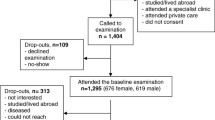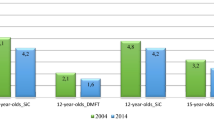Abstract
Aim: This was to determine the increment of caries from 12 to 18 years of age and to explore the possibility of predicting caries increment in this period based on the caries experience at age12 years. Study design: Prospective longitudinal survey. Methods: A sample of 12-year-old children (n =159) were examined in 1993 and 70% of them re-examined at 18 years of age. Bitewing radiographs were taken and a diagnostic system using five caries grades (D1−D5) was used at both ages. Children at risk were defined as those who developed manifest caries lesions (D3−5FS) on approximal surfaces during the follow-up period. Possible predictors were analysed by calculation of sensitivity, specificity, and actual proportion of the population at risk. Results: The mean caries increment (D1−5MFS) from 12 to 18 years of age was 4.2 (SD±9.1). The percentage of caries-free adolescents at 12 and 18 years of age was 10% and 1% respectively; 25% had either a reversal or no increment in caries experience while the D1−5MFS increased in 65% of the adolescents. Of the increment of manifest lesions (D3−5FS), 18% were located in incisors/canines, 40% in premolars, 26% in first molars and 16% in second molars. Premolars had the largest proportion of the approximal surfaces with manifest caries increment. The best predictors of children at risk of approximal caries increment (D3−5FS) were caries experience (D1−5FS) on the approximal surfaces of premolars and second molars at the age of 12 years. The individuals that developed four or more manifest lesions on approximal surfaces between 12 and 18 years were the easiest to predict (sensitivity + specificity = 175%). Conclusions: There was a considerable increment of manifest caries lesions from 12 to 18 years of age in all tooth groups. The best predictors for increment of manifest caries on approximal surfaces during the age period were approximal caries in premolars and second molars at the age of 12 years.
Similar content being viewed by others
References
Amarante E, Raadal M, Espelid I. Impact of diagnostic criteria on the prevalence of dental caries in Norwegian children aged 5, 12 and 18 years. Community Dent Oral Epidemiol 1998; Apr; 26(2):87–94.
Amarante E. Prevalence of dental caries and periodontal disease in 5-, 12-, and 18-year-old children in Bergen, Norway (M.Sc. thesis). Bergen, University of Bergen, 1995.
Axelsson P, Paulander J, Nordkvist K, Karlsson R. Effect of fluoride containing dentifrice, mouthrinsing, and varnish on approximal dental caries in a 3-year clinical trial. Community Dent Oral Epidemiol 1987;Aug;15(4):177–180.
Batchelor PA, Sheiham A. Grouping of tooth surfaces by susceptibility to caries: a study in 5–16 year-old children. BMC Oral Health 2004 Oct 28; 4(1):2.
Bjarnason S, Kohler B, Wagner K. A longitudinal study of dental caries and cariogenic microflora in a group of young adults from Goteborg. Swed Dent J 1993;17(5):191–199.
Dummer PMH, Addy M, Oliver SJ, et al. Changes in the distribution of decayed and filled tooth surfaces and the progression of approximal caries in children between the ages of 11–12 years and 15–16 years. Br Dent J 1988;May;164(9):277–282.
Eklund SA, Ismail AI. Time of development of occlusal and proximal lesions: implications for fissure sealants. J Public Health Dent 1986 Spring; 46(2):114–121.
Espelid I, Tveit AB, Mjor IA, et al. [Systems for grading occlusal and approximal carious lesions]. Nor Tannlaegeforen Tid 1990 Oct; 100(16):658–663.
Glass RL. The first international conference on the declining prevalence of dental caries. J Dent Res 1982;61:1304–1383.
Haugejorden O, Birkeland JM. Evidence for reversal of the caries decline among Norwegian children. Int J Paediatr Dent 2002;Sep;12(5):306–315.
Hausen H, Karkkainen S, Seppa L. Application of the high-risk strategy to control dental caries. Community Dent Oral Epidemiol 2000;Feb; 28(1):26–34.
Ismail AI. Clinical diagnosis of precavitated carious lesions. Community Dent Oral Epidemiol 1997;Feb; 25(1):13–23.
Ismail AI, Brodeur JM, Gagnon P, et al.Prevalence of non-cavitated and cavitated carious lesions in a random sample of 7-9-year-old schoolchildren in Montreal, Quebec. Community Dent Oral Epidemiol 1992;Oct;20(5):250–255.
Kingman A. Statistical issues in risk assessment in dentistry. In: Bader Jd (eds). Risk assessment in dentistry. Chapel Hill: University of North Carolina Dental Ecology; 1990. pp 193–200.
Landis JR, Koch GG. The measurement of observer agreement for categorical data. Biometrics 1977;Mar; 33(1):159–174.
Locker D, Liddell A, Dempster L, Shapiro D. Age of onset of dental anxiety. J Dent Res 1999 Mar; 78(3):790–796.
Macek MD, Heller KE, Selwitz RH, Manz MC. Is 75 percent of dental caries really found in 25 percent of the population? J Public Health Dent 2004;Winter;64(1):20–25.
Mejare I, Kallestål C, Stenlund H, Johansson H. Caries development from 11 to 22 years of age: a prospective radiographic study. Prevalence and distribution. Caries Res 1998;32(1):10–16.
Mejare I, Kallestål C, Stenlund H. Incidence and progression of approximal caries from 11 to 22 years of age in Sweden: A prospective radiographic study. Caries Res 1999;33(2):93–100.
Mjor IA, Dahl JE, Moorhead JE. Placement and replacement of restorations in primary teeth. Acta Odontol Scand 2002;Jan;60(1):25–28.
Munro BH. Statistical Methods for Health Care Research Philadelphia, Lippincott Williams & Wilkins.2005.
Newburn E, Leverett D. Risk assessment dental caries working group summary statement. In: Bader Jd (eds). Risk assessment in dentistry. Chapel Hill: University of North Carolina Dental Ecology; 1990. pp 304–305.
Pitts NB. Current methods and criteria for caries diagnosis in Europe. J Dent Educ 1993; 57(6):409–414.
Qvist V, Thylstrup A, Mjor IA. Restorative treatment pattern and longevity of resin restorations in Denmark. Acta Odontol Scand 1986;Dec;44(6): 351–356.
Raadal M. Management of early carious lesions in primary teeth. In: Hugoson A, Falk M, Johansson S. (eds). Management of early carious lesions in primary teeth. Stockholm: Forlagshuset Gothia; 2002. pp 48–56.
Raadal M, Espelid I, Mejare I. The caries lesion and its management in children and adolescents. In: Koch G, Poulsen, S (eds). Pediatric dentistry — a clinical approach. Copenhagen: Munksgaard; 2001. pp 173–212.
Seppa L, Hausen H, Pollanen L, Helasharju K, Karkkainen S. Past caries recordings made in Public Dental Clinics as predictors of caries prevalence in early adolescence. Community Dent Oral Epidemiol 1989;Dec;17(6):277–281.
Skaret E, Raadal M, Berg E, Kvale G. Dental anxiety and dental avoidance among 12 to 18 year olds in Norway. Eur J Oral Sci 1999;Dec;107(6): 422–428.
Skold UM, Klock B, Lindvall AM. Differences in caries recording with and without bitewing radiographs. A study on 5-year old children in the County of Bohuslan, Sweden. Swed Dent J 1997; 21(3):69–75.
Stamm JW, Disney JA, Graves RC, Bohannan HM, Abernathy JR. The University of North Carolina Caries Risk Assessment Study. I: Rationale and content. J Public Health Dent 1988 Fall; 48(4):225–232.
Statens helsetilsyn. Tenner for livet. Helsefremmende og forebyggende arbeid. IK-2659 Oslo, Statens helsetilsyn.1999.
Statens helsetilsyn, Sosial- og helsedirektoratet. årsmelding for Den offentlige tannhelsetjenesten 2001 Oslo, Statens helsetilsyn. 2003.
Tveit AB, Espelid I, Mjor IA, et al. [New criteria for secondary decay and marginal defects]. Nor Tannlaegeforen Tid 1990 Oct; 100(16):652–656.
Verrips GH, Kalsbeek H, Eijkman MA. Ethnicity and maternal education as risk indicators for dental caries, and the role of dental behavior. Community Dent Oral Epidemiol 1993 Aug; 216(4):209–214.
von der Fehr FR. Caries prevalence in the Nordic countries. Int Dent J 1994 Aug; 44(4 Suppl 1):371–378.
Wang NJ, Holst D. Individualizing recall intervals in child dental care. Community Dent Oral Epidemiol 1995; 23(1):1–7.
Author information
Authors and Affiliations
Corresponding author
Rights and permissions
About this article
Cite this article
David, J., Raadal, M., Wang, N.J. et al. Caries increment and prediction from 12 to 18 years of age: A follow-up study. Eur Arch Paediatr Dent 1, 31–37 (2006). https://doi.org/10.1007/BF03320812
Published:
Issue Date:
DOI: https://doi.org/10.1007/BF03320812




